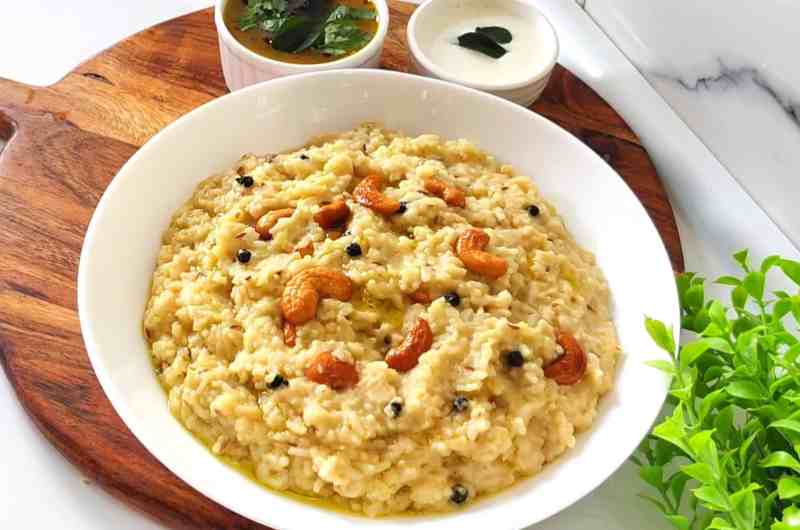The Most Delicious Ven Pongal Recipe
Pongal is a traditional South Indian dish that is popular as a breakfast or brunch dish. It is a lentil dish that has a smooth, porridge-like consistency and a topping of cashew nuts and ghee. Pongal is a special dish, especially during festive occasions in South Indian homes. Pongal can be made in different ways; the savory version is called ven pongal, and the sweet version is called sakkarai pongal. Ven pongal usually pairs well with coconut chutney, sambar, and vadai as side dishes. It is a popular dish in Tamil Nadu, Andhra Pradesh, and southern India and is also a part of the harvest festival of Makar Sankranti.

Pongal is a traditional South Indian dish that has a rich history dating back to ancient times. It is believed to have originated in the state of Tamil Nadu and was traditionally made as a way to celebrate the harvest festival of Makar Sankranti and the Pongal festival. You can make pongal by cooking rice and yellow moong dal or toor dal together with curry leaves, cumin seeds, and whole black pepper, and seasoning it with ghee and cashew nuts.
Pongal is deeply rooted in the culture and customs of the region. It is popular during holidays, and stands as a symbol of abundance and prosperity. Pongal is also a popular dish in South Indian restaurants and is common as a breakfast or brunch dish. It is famous for its smooth, porridge-like consistency and nice aroma. It is a great option for those looking to try a traditional South Indian dish.
In the past, Pongal was primarily made as a savory dish and served as a breakfast or brunch dish. The sweet version of Pongal, known as Sakkarai Pongal, is equally popular, and you can make it by adding jaggery syrup to the dish. You can cook it over a stove top, in pressure cooker or an instant pot, and you can make it with regular rice, brown rice, or Seeraga samba rice. The recipe card for making pongal is easy to follow and includes detailed step-by-step pictures and a list of key ingredients.
Ingredients For Pongal Recipe
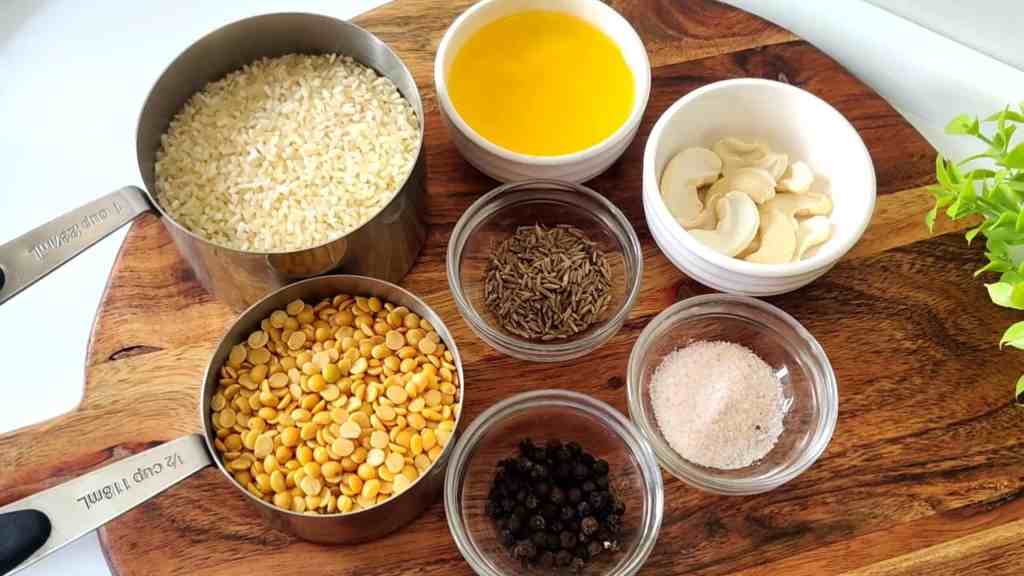
Spices
Cumin seeds and peppercorns add a warm, earthy taste with a slight hint of heat from the peppercorns. They also contribute to the aroma of the dish with their unique, nutty aroma.
Ghee
Ghee is for sautéing the cumin seeds and peppercorns and also to fry the cashews. It also provides a rich, buttery flavor and aroma which contribute to the overall taste of the Pongal.
Lentils
Sambar dal (toor dal) adds a nutty flavor and is rich in protein. Soak the lentils for 20 minutes and rinse them well before cooking, this will help to cook them faster and make them tender.
Rice
Basmati rice provides the base for the dish along with the lentils and spices. It also contributes to the nutty flavor and long, slender grains that give the dish its texture.
Salt
This ingredient enhances the flavor of the dish.
Nuts
Cashews, add a nice crunchy texture to the dish and a subtle sweetness that complements the savory flavors of the Pongal. You will fry ¼ cup of cashews in ghee and add it to the dish as a garnish.
Step By Step Instructions For Pongal Recipe
Start by heating a pressure cooker on medium flame, add 2 Tbsp of ghee and let it heat up.

Once the ghee is hot, add 1 Tbsp cumin seeds and 1 Tbsp peppercorns. Fry them until fragrant.

Add ½ cup of sambar dal (toor dal) that has been soaked for 20 minutes and rinsed well.
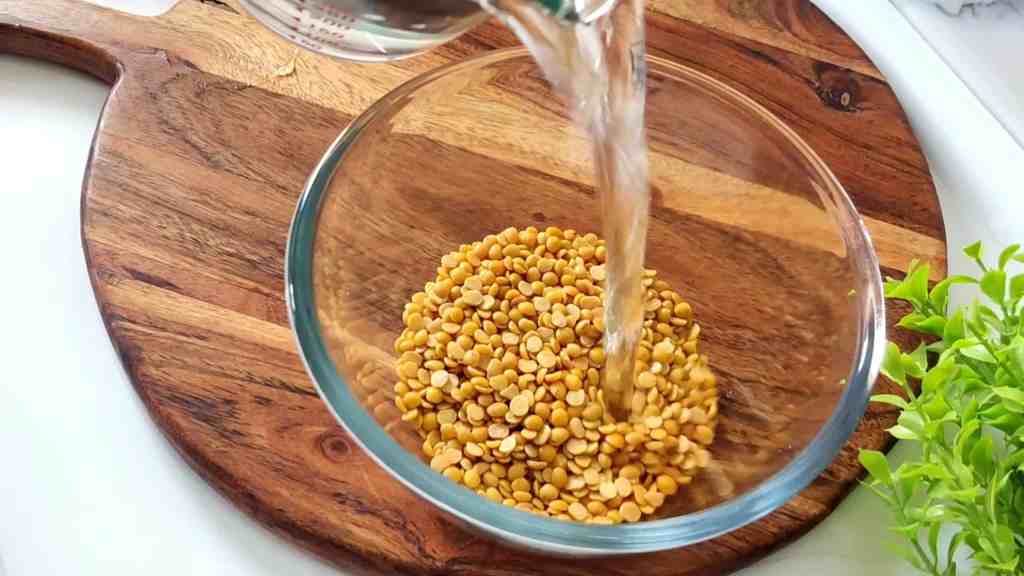
Stir-fry the dal until it turns golden brown.

Add 2 cups of water to the dal.
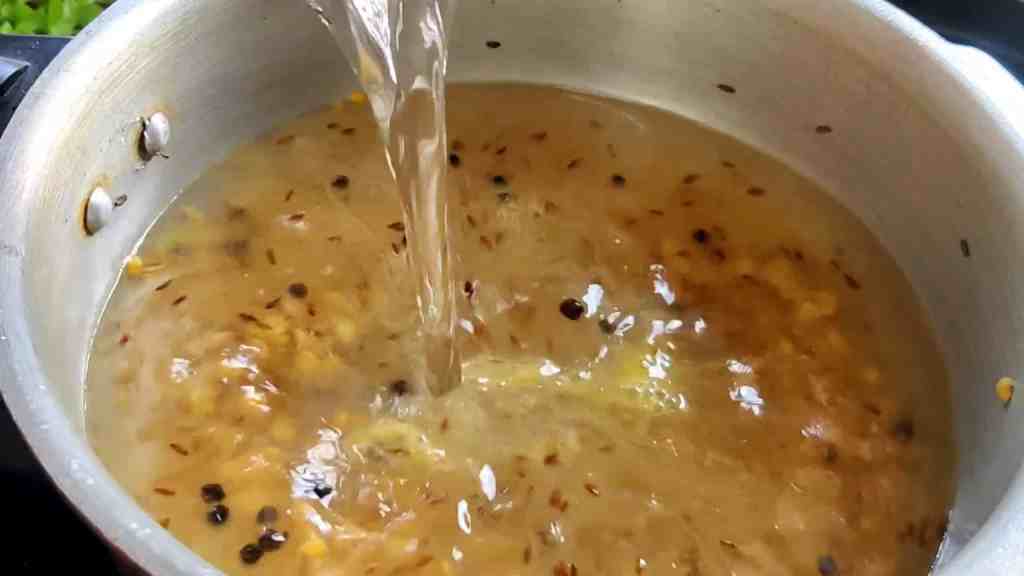
Then add 1 cup of basmati rice, and 1 tsp of salt to the pressure cooker. Mix everything well.
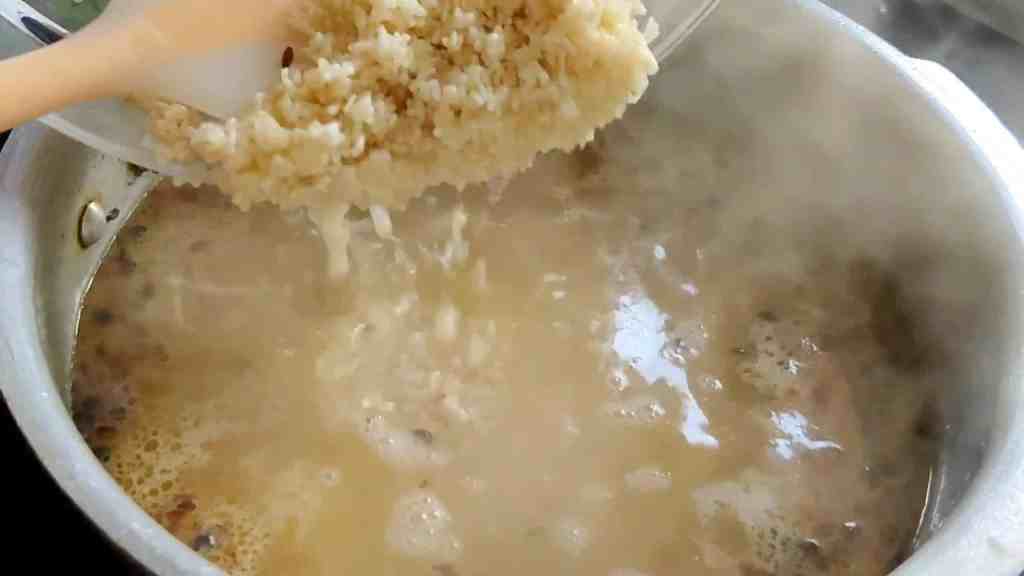
Close the lid of the pressure cooker, and cook the mixture on high heat for 2-3 whistles.

If cooking in a pot, turn the flame to low and simmer until the rice and dal are tender and soft.

In a small pan, heat ¼ cup of ghee and add ¼ cup of cashews halved. Fry them until golden brown.

Once you release the pressure, open the lid of the pressure cooker and add the fried cashews to the rice mixture.

Serve the Pongal hot with sambar and coconut chutney as side dishes. Enjoy!

Serving Suggestions
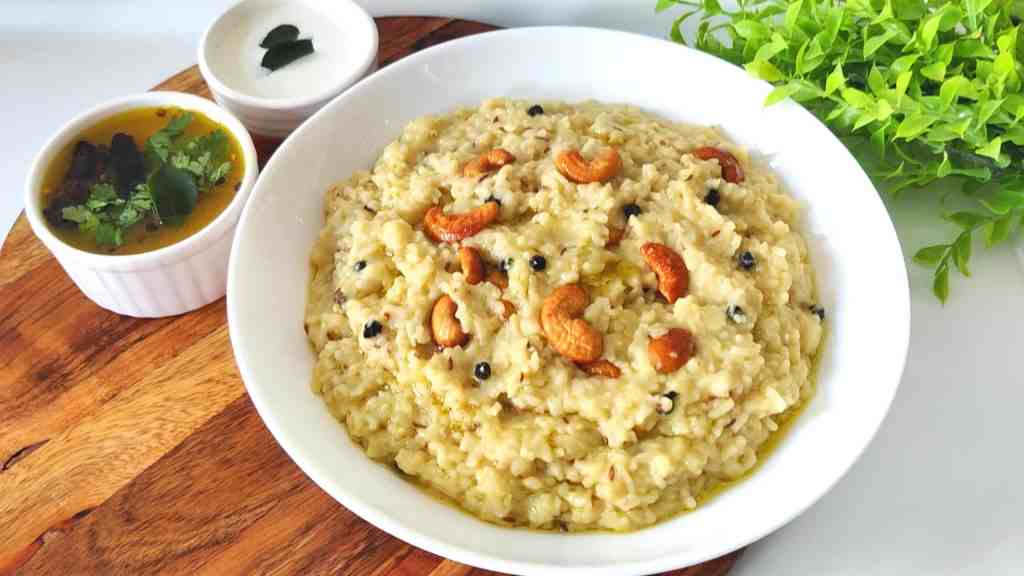
Pongal is a versatile dish that you can easily serve in a variety of ways. One popular way to serve Pongal is with sambar and coconut chutney as side dishes. The sambar, a lentil-based stew, provides a savory and tangy contrast to the rich and nutty Pongal. The coconut chutney, made from grated coconut, green chilies, and other spices, adds a fresh and creamy element to the dish. Together, these sides complement the flavors and textures of the Pongal perfectly.
Another way to serve Pongal is with a side of medu vada, a popular South Indian lentil doughnut that is crispy on the outside and soft on the inside. The vada’s texture and flavor provide a great contrast to the creamy and nutty Pongal. Additionally, Pongal also goes well with Lemon rice, which is rice with lemon juice, mustard seeds, and curry leaves. The tangy and aromatic Lemon rice adds a nice balance to the rich and nutty Pongal. You can also serve Pongal as a main dish with a salad or Raita/pachadi, a yogurt-based condiment, on the side.
Storage Suggestions For Pongal
Storing Pongal properly will ensure that it stays fresh and delicious for a longer period of time. One way to store Pongal is to transfer it into an airtight container and place it in the refrigerator. Make sure to cool the Pongal down to room temperature before storing it in the refrigerator to avoid any condensation that can cause spoilage. Another way to store Pongal is by freezing it. To do this, place the Pongal in an airtight container or a freezer-safe bag and seal it tightly. Make sure to remove as much air as possible to prevent freezer burn. You can store Pongal for up to 3 months in the freezer. When you’re ready to eat it, thaw the Pongal in the refrigerator overnight and then heat it on the stovetop or in a microwave.
Frequently Asked Questions
Khara pongal is the same or similar to ven pongal. It is a savory version of pongal, a traditional South Indian dish made with rice and lentils. You can make it with a combination of moong dal and rice, and seasoned with spices such as cumin, pepper, and green chilies.
The Pongal festival is typically celebrated in January, marking the start of the harvest season in Southern India.
The exact amount of water needed to make Pongal will vary depending on the recipe and the type of rice used. Typically, you will need 2 cups of water for every cup of rice.
Sweet pongal, also known as sakkarai pongal, is made with jaggery syrup and milk, and has a sweet flavor. Khara pongal, on the other hand, uses lentils and spices, and has a savory flavor.
The number of whistles that a pressure cooker gives when the Pongal is cooked varies depending on the cooker. Typically, it takes 2-3 whistles for Pongal to be cooked.
Yes, you can make ven pongal recipe in an instant pot. Follow the recipe as you would for stovetop pressure cooker and adjust the cooking time according to the instructions for your instant pot.
Yes, you can make pongal with brown rice. The taste will be different, but give it a try if you’d like.

Hi! I’m Ravi Kumar.
I am a husband, father of 4, board certified neurosurgeon, and a lover of South Indian Food!
I created PaattisKitchen.com to memorialize the most delicious foods on earth. South Indian food is easy to make and hard to mess up. So pull up your sleeves, and come with me as we explore the vibrant spices, colors, aromas, and flavors of South Indian culinary tradition.

Hi! I’m Ravi Kumar.
I am a husband, father of 4, board certified neurosurgeon, and a lover of South Indian Food!
I created PaattisKitchen.com to memorialize the most delicious foods on earth. South Indian food is easy to make and hard to mess up. So pull up your sleeves, and come with me as we explore the vibrant spices, colors, aromas, and flavors of South Indian culinary tradition.

